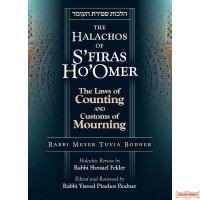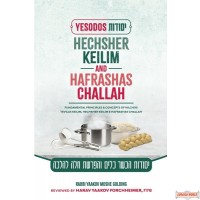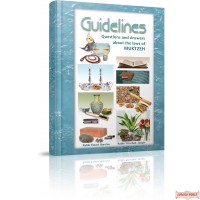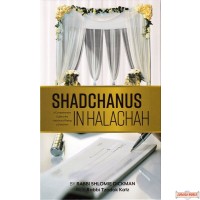Jewish Law & Observance
The period between Pesach and Shavuos comes with the customs and sadness of mourning and the joyful halachos of counting S’firas Ho’Omer. In this book, Rabbi Meyer Bodner adapts the style and clarity of his distinguished father’s widely circulated sefarim (Halachos of Muktza, Halachos of Brochos, etc.) to elucidate the practical need-to know customs and halachos of S’firas Ho’Omer.
For example:
- May one attend and dance at a friend’s wedding and Sheva Brochos on days when it is his custom to show aveilus?
- Is it permitted to listen to relaxing music when it is his custom to show aveilus?
- May a women cut her nails, tweeze her eyebrows or have electrolysis done while keeping the customary aveilus?
- Is it permitted to take a haircut or shave on the first day of Shloshes Yemei Hagbola?
- May a bar mitzvah celebration be scheduled on a day other than the boy’s birthday (not bo b’yom)?
- If one mistakenly counted the days but omitted the weeks, or cannot remember if yesterday he counted correctly, may he continue counting with a brocha?
- May a woman count with a brocha and may she be motzi her friend?
Reviewed for halachic accuracy by Rabbi Shmuel Felder shlit”a and edited and reviewed by Rabbi Yisroel Pinchos Bodner shlit”a, this sefer accurately provides the answer to these and a myriad of other questions and quandaries concerning the customs and halachos of S’firas Ho’Omer. Learn More
FUNDAMENTAL PRINCIPLES & CONCEPTS OF HILCHOS TEVILAS KEILIM, HECHSHER KEILIM & HAFRASHAS CHALLAH
Could glass be kashered? Does it need to be kashered?
If one cannot remove a stain from a keili, can it be kashered?
Does a pushpin use to design a cake require tevillah?
Does a keili that is always used with parchment paper require tevillah?
What happens if one divides five pounds of dough into many parts, freezes them, and only takes out one at a time to bake?
If one makes a few small batches of dough, how can they be combined together to be obligated in challah?This sefer explains fundamental principles and concepts in a short and clear style in order to be able to understand the complicated halachos of hechsher keilim, tevillas keilim, and hafrashas challah.
- Know when and how to ask a shailah.
- Know and understand common daily halachos.
- Clear and practical guide for kashering a kitchen for Pesach or from a non-Jew.
- A great way to review the halachos in an organized and systematic format.
- For those who never had the opportunity to learn it and for those who have learned it many times Learn More
- Every seven years in the land of Israel the Jewish people excitingly prepare for one of the most interesting and novel time bound Mitzvos available today, the laws of Shemita. Whether you are somebody who runs a farm, or simply own some trees in your backyard, or have plants or a garden, there are many detailed laws that you need to know regarding how to upkeep your land/garden/plant during the Shemita year, the restricted activities, the permissibility to eat the produce, and the need to make it available for the public to eat. Furthermore, even if you do not own any plants gardens or fruit trees, the simple consumer in Israel during the Shemita year needs to be aware of the various Rabbinical supervisions available for Shemita produce and the differences between them, such as for example if one may one rely on what is called Heter Mechirah. In the event of them buying produce that grew during the year of Shemita, known as Otzer Beis Din, they must be aware of how to treat this produce and know the restrictions and limitations of eating it.? Last but not least, this book contains a chapter that is relevant for all Jewry even of the Diaspora, dealing with the laws of Shemitas Kesafim, abolishing debts that took place prior to the Shemita year and the details of a Peruzbal. Interestingly, the laws of Shemita are not found in the Shulchan Aruch, and therefore alternative sources had to be used to compile a final ruling regarding the subject. The laws dealing with Shemita in this book have been compiled from a variety of sources, being heavily based on the rulings of the Rambam, with the final arbitrations for today’s times taken from the Gedolei HaPoskim, including the Peas Hashulchan, Ridbaz, Chazon Ish, Rav Avraham Chaim Na’ah, the Sefer Minchas Yerushalayim, Toras Hashemitah. The laws dealing with Shemitas Kesafim have been compiled from the Shulchan Aruch of the Alter Rebbe, together with the rulings of the Achronim. Learn More
- It is with great thanks to the Almighty that we present to you this short booklet which contains a quick summary of the necessary laws of the Pesach Seder, especially focusing on the directives applicable during the Seder itself. The purpose of this booklet is for it to be used as a reference guide during the Seder itself, to look up the detailed directives before each part of the Seder and it is hence advised to be kept in one’s Pesach cabinet free of Chametz, so it can be used on the Seder table. The sources have been allocated from the Shulchan Aruch Harav, Chabad Custom, and from the many works of the Achronim. Detailed sources can be found in our corresponding Sefer on the laws of the Pesach Seder, and the referenced sources [i.e. Chapter 3 Halacha 5] refer to it. Due to the concise nature of this booklet, we have not included all opinions, customs, and reasons in the laws mentioned here, and further information can be gleaned from our corresponding book. Learn More
A Momentous Day... A Treasure for Life
The Bar Mitzvah and Tefillin Handbook focuses on one of the most meaningful milestones in a young man’s life. Geared toward the bar mitzvah boy and his parents, this comprehensive handbook includes:
• Halachos regarding the date of bar mitzvah, the seudas mitzvah, the berachah of Baruch Shepetarani, the obligation for an aliyah, and more.
• An illustrated step-by-step guide to putting on tefillin.
• Powerful words and blessings of gedolei Yisrael for this auspicious day.
• An intriguing mix of commentary and stories from our gedolim as well as contemporary examples on the theme of bar mitzvah and tefillin.Rabbi Dovid Weinberger presents relevant traditions, laws, and customs in a clear, concise language and style, affording the bar mitzvah boy and his parents the ability to learn and review them regularly. This book will prove to be an invaluable resource for every frum family. Learn More
- "These books have been praised highly by numerous Gedolei HaRabbonim and have been received warmly by the English speaking Torah community. I offer my heartfelt blessing that they should have much success in pubishing further works and disseminating the Torah."Rabbi Chaim Pinchus Sheinberg zt'lRosh Hayeshiva Torah Ore and Moreh Horaah of Kiryat Mattersdorf, Jerusalem"As with their other works in the "Guidelines" series, this sefer is concise, accurate, and well structured. The authors have performed a great service, presenting these vital and complex laws in a clear and straightforward questions and answers format"Rabbi Pesach Eliyahu FalkGateshead England, author of "Modesty - An Adornment for Life""As in the previous volumes, the laws and customs are presented in a concise, lucid, and organized fashion. This volume, as well as the entire complete series of Guidelines, will serve as a guide for those who cannot learn these laws from their original sources, and as a valuable aid even to those who can."Rabbi Zev LeffRosh Hayeshiva and Rav of Moshav Matisyahu Learn More
- The study of Shulchan Aruch at times is very challenging in terms of clarifying the final stance of the learned subject. This especially applies in instances that many cases and opinions exist within a given topic. In addition, throughout the generations hundreds of practical questions on the laws in Shulchan Aruch arose. Getting a proper grasp on the laws of Yom KIppur especially faces this challenge due to the complexity of the cases and the range of opinions. Even amongst the currently available English literature, the opinion of the greatest of the Achronim, the Shulchan Aruch Harav, is many times omitted or not given its proper presence. Likewise, the Chabad custom related to Yom Kippur is not given their proper presence. This Sefer tackles all the above deficiencies. A clear summary of the rulings of the Shulchan Aruch Harav and Chabad custom, supplemented with the opinions of the Mishneh Berurah and Kaf Hachaim. This is accompanied with hundreds of practical Q&A that were compiled from classical Halachic sources. All this is compiled with informative footnotes that lend the reader background information and other opinions voiced on the subject matter. Learn More
"These books have been praised highly by numerous Gedolei HaRabbonim and have been received warmly by the English-speaking Torah community. I offer my heartfelt blessing that they should have much success in publishing further works and disseminating the Torah."
Rabbi Chaim Pinchas Scheinberg zt"l
Rosh Hayeshiva Torah Ore and Moreh Hora'ah of Kiryat Mattersdorf, Jerusalem
"As with their other works in the 'Guidelines' series, this sefer is concise, accurate, and well structured. The authors have performed a great service, presenting these vital and complex laws in a clear, straightforward questions-and-answers format."
Rabbi Pesach Eliyahu Falk
Gateshead, England, author of "Modesty - An Adornment for Life"
"As in the previous volumes, the laws and customs are presented in a concise, lucid, and organized fashion. This volume, as well as the entire complete series of Guidelines, will serve as a guide for those who cannot learn these laws from their original sources, and as a valuable aid even to those who can."
Rabbi Zev Leff
Rosh Hayeshiva and Rav of Moshav Matisyahu Learn More
- Man or woman, learned or unlearned, professional or amateur, a shadchan is an osek b'tzarchei tzibbur, who with each successful shidduch builds the foundation of a bayis neeman b'yisrael. "Shadchanus" is the payment that is given upon the completion of a shidduch to express appreciation for the great joy the shadchan has brought into your life.
How is shadchanus viewed in halachah? Is it only a gift to express appreciation for a job well done, or is it a required payment that must be given upon completion of a shidduch? How much should be given? When must shadchanus be paid - when the shidduch is finalized or at the wedding? When there are multiple shadchanim, how is the shadchanus divided?
These, and many other questions, are answered in this new sefer, Shadchanus in Halacha. Written by Rabbi Shloime Dickman, and shadchan Rabbi Tzodok Katz, Shadchanus in Halacha explains the role and function of the modern-day shadchan, outlines the halachos and minhagim of giving shadchanus, and presents a series of fifteen fascinating real-life shailos and teshuvos on the topic.
Shadchanus in Halacha will educate and entertain, as it makes an enigmatic topic in halacha clear to all. Learn More
- These books have been praised highly by numerous Gedolei HaRabbonim and have been received warmly by the English-speaking Torah community... I offer my heartfelt blessing that they should have much success in publishing further works and disseminating the Torah." -- Rabbi Chaim Pinchas Scheinberg, zt"l, Rosh Hayeshiva Torah Ore and Moreh Hora'ah of Kiryat Mattersdorf, Jerusalem
"As with their other works in the "Guidelines" series, this sefer is concise, accurate, and well-structured. The authors have performed a great service, presenting these vital and complex laws in a clear and straightforward question-and-answer format." -- Rabbi Pesach Eliyahu Falk, Gateshead, England, author of Modesty - An Adornment for Life
"As in the previous volumes, the laws and customs are presented in a concise, lucid, and organized fashion. This volume, as well as the entire complete series of Guidelines, will serve as a guide for those who cannot learn these laws from their original sources, and as a valuable aid even to those who can." -- Rabbi Zev Leff, Rosh Hayeshiva and Rav of Moshav Matisyahu Learn More












